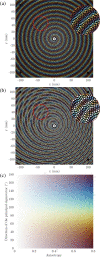Morphogenetic metasurfaces: unlocking the potential of turing patterns
- PMID: 37803018
- PMCID: PMC10558543
- DOI: 10.1038/s41467-023-41775-9
Morphogenetic metasurfaces: unlocking the potential of turing patterns
Erratum in
-
Author Correction: Morphogenetic metasurfaces: unlocking the potential of Turing patterns.Nat Commun. 2024 May 2;15(1):3701. doi: 10.1038/s41467-024-47832-1. Nat Commun. 2024. PMID: 38697965 Free PMC article. No abstract available.
Abstract
The reaction-diffusion principle imagined by Alan Turing in an attempt to explain the structuring of living organisms is leveraged in this work for the procedural synthesis of radiating metasurfaces. The adaptation of this morphogenesis technique ensures the growth of anisotropic cellular patterns automatically arranged to satisfy local electromagnetic constraints, facilitating the radiation of waves controlled in frequency, space, and polarization. Experimental validations of this method are presented, designing morphogenetic metasurfaces radiating far-field circularly polarized beams and generating a polarization-multiplexed hologram in the radiative near-field zone. The exploitation of morphogenesis-inspired models proves particularly well suited for solving generative design problems, converting global physical constraints into local interactions of simulated chemical reactants ensuring the emergence of self-organizing meta-atoms.
© 2023. Springer Nature Limited.
Conflict of interest statement
The authors declare no competing interests.
Figures





Similar articles
-
Multi-beam reflections with flexible control of polarizations by using anisotropic metasurfaces.Sci Rep. 2016 Dec 21;6:39390. doi: 10.1038/srep39390. Sci Rep. 2016. PMID: 28000734 Free PMC article.
-
Shaping electromagnetic waves using software-automatically-designed metasurfaces.Sci Rep. 2017 Jun 15;7(1):3588. doi: 10.1038/s41598-017-03764-z. Sci Rep. 2017. PMID: 28620212 Free PMC article.
-
Achieving circular-to-linear polarization conversion and beam deflection simultaneously using anisotropic coding metasurfaces.Sci Rep. 2019 Aug 22;9(1):12264. doi: 10.1038/s41598-019-48812-y. Sci Rep. 2019. PMID: 31439917 Free PMC article.
-
Chemical morphogenesis: turing patterns in an experimental chemical system.Acta Biotheor. 1996 Nov;44(3-4):249-61. doi: 10.1007/BF00046531. Acta Biotheor. 1996. PMID: 8953211 Review.
-
Insights from chemical systems into Turing-type morphogenesis.Philos Trans A Math Phys Eng Sci. 2021 Dec 27;379(2213):20200269. doi: 10.1098/rsta.2020.0269. Epub 2021 Nov 8. Philos Trans A Math Phys Eng Sci. 2021. PMID: 34743602 Review.
References
-
- Turing AM. The chemical basis of morphogenesis. Bull. Math. Biol. 1990;52:153–197. - PubMed
-
- Kondo S, Miura T. Reaction-diffusion model as a framework for understanding biological pattern formation. Science. 2010;329:1616–1620. - PubMed
-
- Garvie MR. Finite-difference schemes for reaction–diffusion equations modeling predator–prey interactions in matlab. Bull. Math. Biol. 2007;69:931–956. - PubMed
Grants and funding
LinkOut - more resources
Full Text Sources

